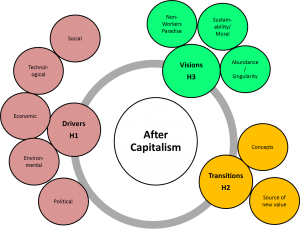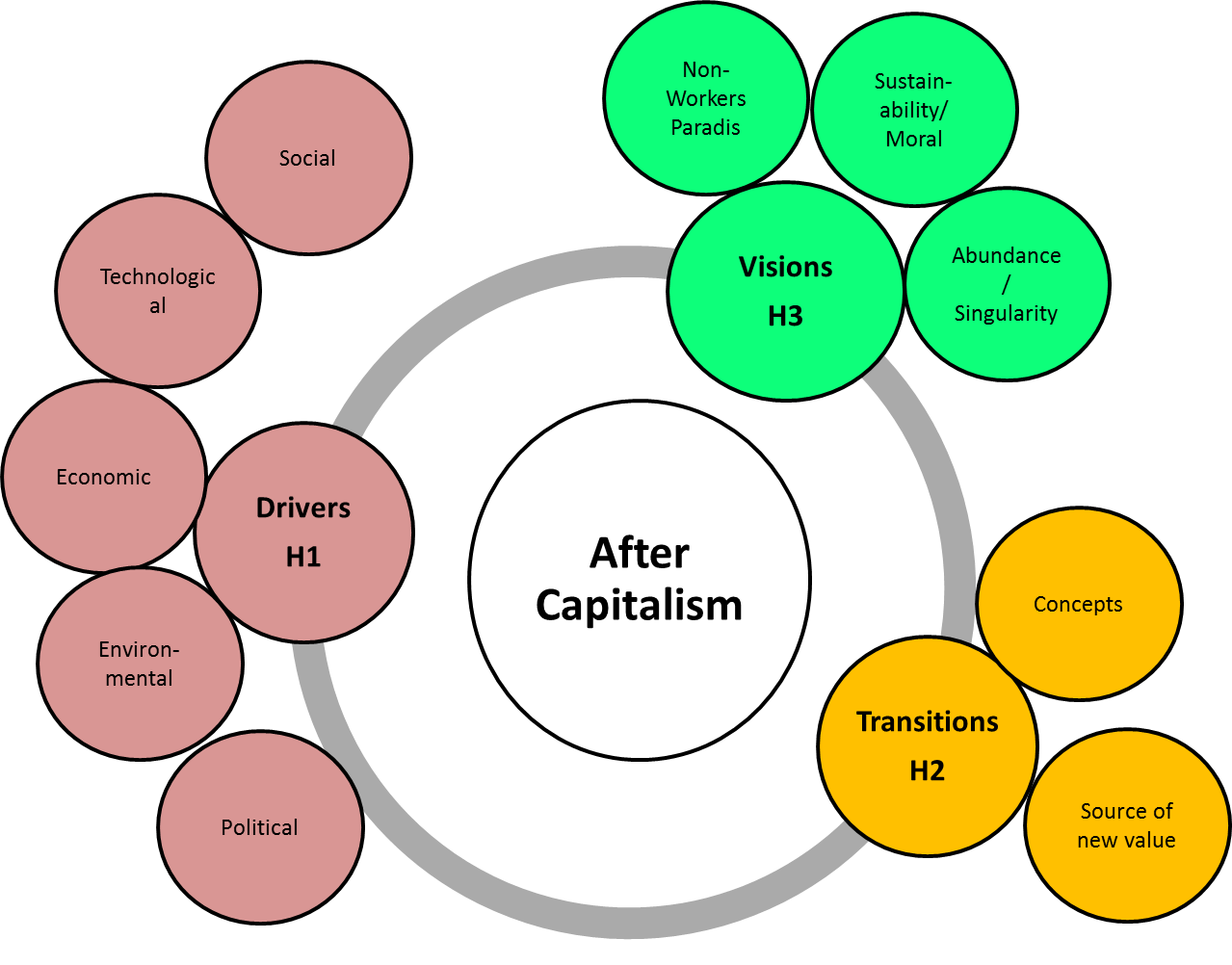I introduced a new framing of the “After Capitalism” project a few weeks ago in a post on “transition.” Let’s look more closely at this reframing, which often happens several times in a book project, and is key to whether it comes together – or not! The revised simple version of the domain map indicates how we’re re-organizing the scanning.

Let’s briefly recall that the initial idea of tracking After Capitalism began five years ago when I started collecting concepts that seemed to address the next socioeconomic system. When those concepts reached what seemed to me to be a critical mass of 40 – without looking too hard – I put together an initial framework that sorted the concepts into umbrella concepts, sources of new values, sustainability, and drivers/enablers/mechanisms. That framework proved a useful starting point in introducing the ideas to audiences.
But, as happens, further scanning and research (mostly books and reports), and ideas from colleagues, drives a search for next framework based on what’s been learned. A key insight, I believe, is that the Three Horizons framework from Curry, Hodgson, and Sharpe provides a more useful organizing approach moving forward:
Horizon 1. Today’s version neoliberal capitalism has served its purpose as an effective system for economic development and growth that fit the modern context, but is an inadequate fit for the emerging postmodern [and to a lesser degree integral] context. We identified three primary challenges to the existing order:
- Inequality
- Ecosystem overload
- Reliance on jobs as wealth distribution
There are many other drivers of change to the system, which we are now organizing by STEEP categories in our scanning. [A tricky issue that we’re wrestling with is sorting the drivers into the various horizons – for now we’re putting them all into H1.]
Horizon 3. We lack clear and compelling positive images of transformation, that is, what is after capitalism, but we have some “seeds”
- Sustainability and moral purpose
- Tech-driven Abundance and the Singularity
- A world without work, which we’re calling, the non-workers paradise
Horizon 2. Transition concepts center on sharing, platforms, and collaboration, which have one foot in the old and one in the new; two issues seem particularly thorny for the move to transformation
- Those supporting transformation have so far been ineffective in mobilizing, compared to the forces supporting the existing system
- Can pockets of transformation catalyze change, that is can ideas like basic income and sustainable development take root in a global context of extreme differences in levels of development; put bluntly, one might imagine these being pioneered in affluent postmodern regions; one can also image the modern areas eventually making the transition, but can the destitute areas leapfrog to transformation without passing the modern phase of development
— Andy Hines

Plug this into the model.
Forecast / assumption: scarcity will end in 50 years.
James Burke asks “… what it [the coming end of scarcity] will mean for us as a species; one whose raison d’etre has been about managing the scarcity of what we need or want. It’s been the impetus to human development since our very beginning and the reason why we have markets and jobs and governments and maths and every other innovation that’s helped us along the way to get us to now….”
For example, “If you don’t need to buy anything anymore, what need would there be for money? Or a job?” and “If nothing is scarce, does anything have value?”
Source: a 28 minute audio at http://www.bbc.co.uk/programmes/b09jvfc4
excellent, thanks so much for adding this. I just finished a book by Charles Eisenstein called Sacred Economics that looks at this very question and has some good insights. Should be blogging on that soon.